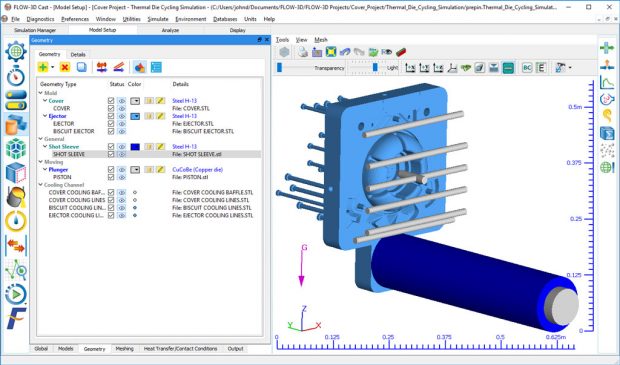
Flow Science has released version 5.0 of its FLOW-3D CAST metal casting simulation software. Shown here is a model setup workspace. Image courtesy of Flow Science Inc.
Latest News
March 21, 2018

Dear DE Reader:
No one could make the phrase “pasteurized processed cheese spread” intriguing like Ed Herlihy, the voice of newsreels and commercials for 50-plus years. If he were here to narrate a report about today's Editor's Pick of the Week, he'd surely say something intriguing about its set of process suites for metal casting simulation.
Flow Science just released version 5.0 of its FLOW-3D CAST well-regarded simulation solution. They call it “major,” and its slew of new functions and enhancements seem to back that up. Among these are a porosity analysis tool for identifying defects and a new feature that lets you calculate the heat transfer coefficient between the spray fluid and the die surface based on the flow rate of the spray fluid at the nozzle.
 Flow Science has released version 5.0 of its FLOW-3D CAST metal casting simulation software. Shown here is a model setup workspace. Image courtesy of Flow Science Inc.
Flow Science has released version 5.0 of its FLOW-3D CAST metal casting simulation software. Shown here is a model setup workspace. Image courtesy of Flow Science Inc.One nifty new functionality is called “void particles.” These particles represent collapsed gas regions. They behave like little bubbles interacting with the metal. When simulating in previous editions of the software, collapsed gas regions would vanish when they became so compressed that they couldn't be resolved in the mesh. Now, you can see them. The upshot is that their location at the end of filling indicates the potential for defects due to air entrainment and/or oxides.
Other notable happenings in FLOW-3D CAST v5 include a new output quantity called Hot Spots for use in mold design. They help you locate and size risers by indicating the last places to solidify. This can help you identify potential solidification-related defects.
Still, it's the process that seems to make this software intriguing. Rather, its “processes.” FLOW-3D CAST doesn't force-feed you a one-size-fits-all metal casting simulation approach.
See, FLOW-3D CAST offers suites of related processes. Once you pick your process, say, high-pressure die casting, your user interface displays only what is relevant to simulating that process. Further, it tailors your process workspace with the appropriate parameters, geometry types and industry defaults.
Within each process workspace, sub-processes like filling, solidification and cooling are connected simulations that run one after another just like on the floor. You can also expand the process to include additional steps you need.
But wait. There's more, he says, channeling Ed Herlihy. But you'll have to read today's Pick of the Week write-up for that. Be sure to hit the link to the FLOW-3D CAST v5 landing page for in-depth details. In short, FLOW-3D CAST v5 sounds like a sweet solution.
Thanks, Pal. – Lockwood
Anthony J. Lockwood
Editor at Large, DE
More Flow Science Coverage
Subscribe to our FREE magazine, FREE email newsletters or both!
Latest News
About the Author
Anthony J. Lockwood is Digital Engineering’s founding editor. He is now retired. Contact him via [email protected].
Follow DE





